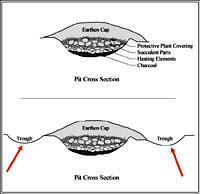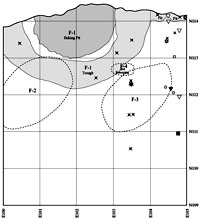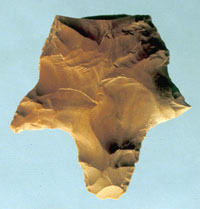Paradise Site
Four thousand years ago, along the headwaters of a major tributary of the Rio Grande, a small band of 15 or 20 people from closely related extended families camped on a terrace overlooking Paradise Draw. The Paradise site (41PS914) is located in the far northwestern corner of the 275,000-acre 02 Ranch in the heart of Big Bend country in Trans-Pecos Texas. They camped at the base of Cartright Mesa which looms 275 meters (900 feet) above the site. Paradise Draw forms the headwaters of the extensive Terlingua Creek before it winds its way south from the site for a distance of 140 kilometers (87 miles) to its confluence with the Rio Grande.
These early campers no doubt had many wooden, bone, and fiber amenities, but only their stone tools survived the thousands of years the site lay buried under alluvial soils. Early in 2004, during a field survey of the O2 Ranch by archeologists from the Center for Big Bend Studies (CBBS), a distinctive cluster of burned rocks was discovered buried in the cutbank of a dry arroyo alongside Paradise Draw. The rocks looked to be part of a discrete Archaic occupation that could provide a well dated component. Archeologists subsequently laid out a 5-x-5 meter grid to encompass this cultural deposit. Excavation of the 25-square meter area uncovered substantial burned rock deposits located a little over a meter below the terrace surface. Other evidence obtained from the surrounding cutbanks and from the excavation indicates that the area excavated is a small part of a much larger site.
Although an unknown portion of this activity area was lost to erosion down the arroyo, a substantial remnant of an earth oven remained, along with two satellite features representing cleanout piles from the dismantling of the oven for reuse, a small hearth utilized by the inhabitants during operation of the oven, and a nearby stone tool workshop. Researchers were also able to identify the original living surface where these people sat and worked. Four radiocarbon assays were obtained from separate features, all yielding dates tightly clustered at about 4,000 years ago.
Only a single projectile point fragment was recovered during excavation: a dart point fragment with a contracting stem, found lying in situ on the living surface. This point is the most firmly dated contracting stem dart point in the Trans-Pecos. Only 15 other tools were recovered during excavation at the Paradise site. They include five small groundstone fragments found heat-fractured in feature soils and most likely present only as heating elements, two stone cores found on the living surface and associated with the stone tool workshop area, and eight expediency tools in the form of small utilized stone chips. Only 147 pieces of stone chipping waste were recovered. By comparison, hunter-gatherer sites in the region often yield several hundred tools and several thousand pieces of chipping waste from an excavation this size.
The earth oven was used for baking desert succulents, probably sotol bulbs. Most researchers agree on the general patterns of earth oven construction�much of it based on ethnographic accounts. Whatever the contents, for an earth oven to operate efficiently it must be covered and sealed with a thick layer of earth. Few researchers have stopped to wonder where this earth would come from, nor have they considered this disturbance when discussing site formation processes and positioning of artifacts.
Evidence for what is herein termed a borrow trough was found crossing the grid and further defining the living surface. It appears that the people constructing this oven were scooping up dirt from the immediate area surrounding the oven to help form the earthen seal. This trough is represented by a deposit of heavily charcoal-stained soil which arcs around the earth oven feature and exhibits distinct edges. The trough is also represented in profiles which bisect it on the west and east sides of the earth oven. This site represents the first documentation of a heretofore unrecorded phase of earth oven construction. The developing aggregation of this feature may represent an early stage in the evolution of ring middens that were later to become so ubiquitous across the landscape of the eastern Trans-Pecos.
The events surrounding the construction of this earth oven probably occurred as follows. A pit was dug to a depth of about 20 cm (8 inches) below the living surface. The soils—which would incidentally include any artifacts present on the surface at that time—were stockpiled nearby. After filling the pit with fuel, covering the fuel with rocks as heating elements, burning the fuel until it was reduced to charcoal, and piling on the succulents to be processed as well as a protective plant covering, the oven would have been sealed with a thick layer of sediments. For an oven this size, close to a ton of earth may have been required.
These sediments would come from the stockpiled backdirt and other nearby sediments. It is at this time that the trough would have been scooped out�along with whatever artifacts were already present in these sediments—in an arc surrounding the earth oven. Other evidence suggests there were a few small borrow pits as well. When the builders of the oven dismantled it and prepared it for reuse, they raked or carried the charcoal-laden deposits across this borrow trough, filling it with charcoal-laden soils, and thereby delineating its edges against the lighter naturally occurring soils.
All this earth moving resulted in many artifacts being recovered in at least secondary or tertiary context. The dearth of artifacts (all recovered from the living surface or from features associated with the living surface), the small variety of lithic materials being reduced (consisting primarily of four material types�three rhyolites and one distinctive chalcedony), and the pristine condition of the component enabled the archeologists to understand the circumstances behind the provenience of almost every artifact and much of the debitage, in order to reconstruct patterns of activity at the site.
In particular, the provenience of 13 flakes and 1 utilized flake of the tiger-striped chalcedony, as well as the rhyolite cores and associated flakes (some of which could be refitted to one of the cores), coupled with the understanding of the soil displacement activities associated with operation of the earth oven, make it possible to reconstruct a probable sequence of events or chain of behavior occurring at this site 4,000 years ago.
During construction of the earth oven and preparation of the succulents for roasting, the people stripped the outer leaves and piled them nearby. While the bulbs of succulents, most likely sotol, were roasting, some of the people remained nearby to process these leaves for making mats, baskets, sandals, packs, etc. They used small, slightly modified blades and chips of stone to remove the barbs along the edges of the leaves. They built a small fire within the borrow trough, possibly for warmth but also to prepare food. They roasted yucca blossoms on the small hearth, indicating that at least one of the two or three times the oven was used was in the spring. They also produced rudimentary tools nearby, probably to create the small blades used for barb removal.
The remnant patterns of their activities indicate well-ordered task-specific work areas, and provide a picture of an unexpected level of organization. They most likely had a system of seasonal rounds, perhaps traveling along Terlingua Creek and seeking lower elevations, possibly even the bottomlands of the Rio Grande, during the winter months, and returning to higher elevations in the spring to harvest succulents and hunt in the upland settings. They may have spent the summer hunting on the higher mesas and the fall harvesting pinyon nuts in the mountain areas and acorns along the higher arroyo systems, before heading south for the winter. Or they may have found the environs of the upper Terlingua Creek basin, known today as Green Valley, sufficient to meet their year-round nutritional needs.
Location, location, location. The camp�s location along a major arroyo system at the base of an extensive mesa adheres to the preference of native groups to situate themselves whenever possible within ecotone settings�areas that straddle at least two different ecozones for greater hunting and gathering potential. They were close to the rocks and sotol they needed for plant processing, and they could gather the fuel they needed for the oven in the nearby arroyo bottoms. While some members of the group stayed behind to tend the oven and process the leaves, others probably took to the surrounding mesas to hunt and possibly to gather grass seeds.
The Paradise site has provided us with a truly unique opportunity to glimpse patterns of behavior in place 4,000 years ago. This will also aid archeologists in the interpretation of similar but less well-preserved cultural remains.
Contributed by Andrea J. Ohl.
Source
Ohl, Andrea J.
2006 The Paradise Site: A Middle Archaic Campsite on the O2 Ranch, Presidio County, Texas. Papers of the Trans-Pecos Archaeological Program No. 2, Center for Big Bend Studies, Sul Ross State University.
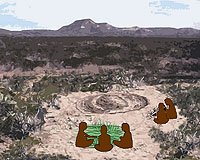
|
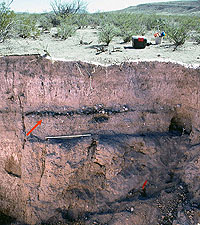
|
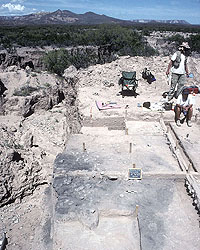
|
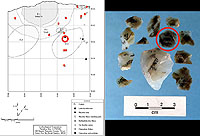
|
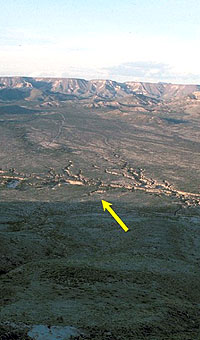
|
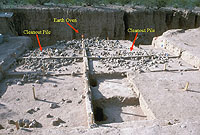
|
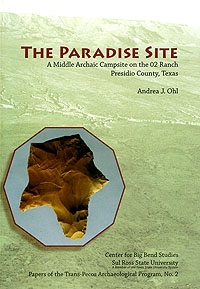
|
